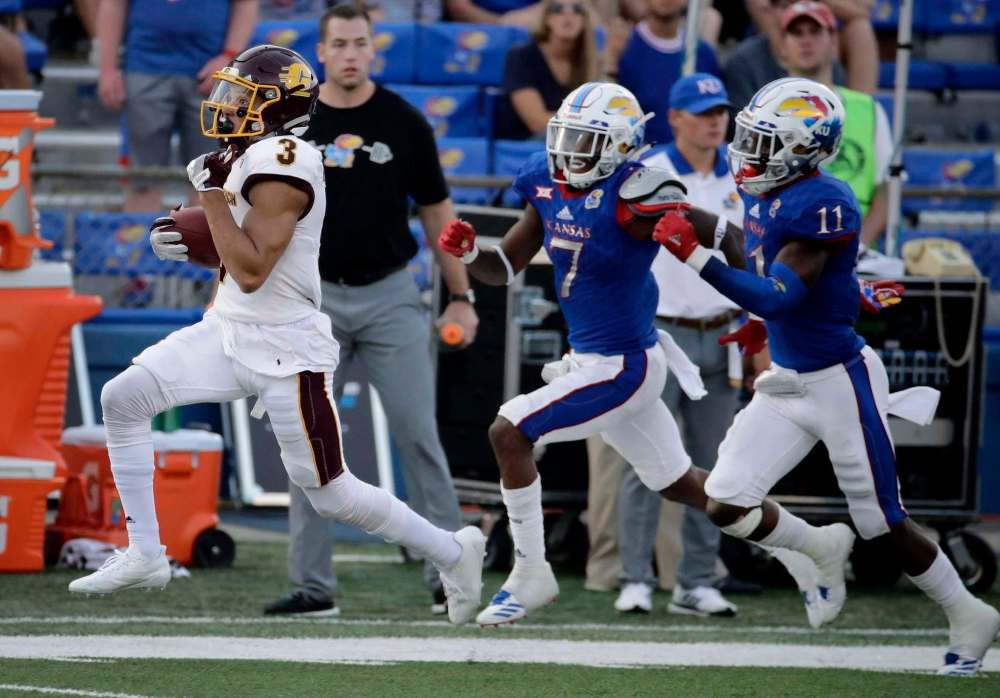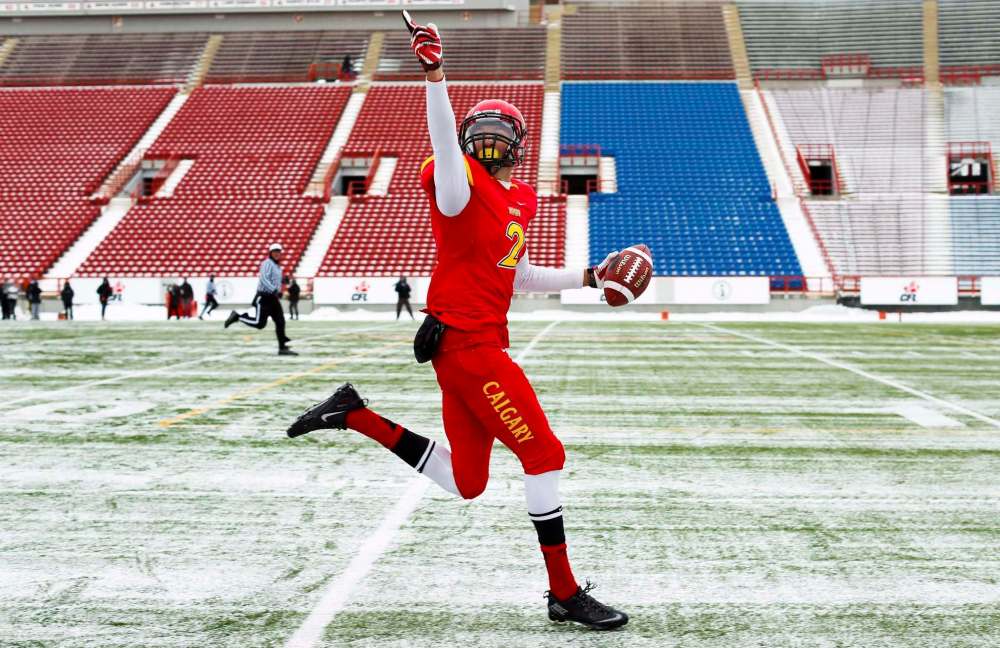Chapman selected first overall in CFL draft
First receiver to go No. 1 in more than a decade
Advertisement
Read this article for free:
or
Already have an account? Log in here »
To continue reading, please subscribe:
Monthly Digital Subscription
$0 for the first 4 weeks*
- Enjoy unlimited reading on winnipegfreepress.com
- Read the E-Edition, our digital replica newspaper
- Access News Break, our award-winning app
- Play interactive puzzles
*No charge for 4 weeks then price increases to the regular rate of $19.00 plus GST every four weeks. Offer available to new and qualified returning subscribers only. Cancel any time.
Monthly Digital Subscription
$4.75/week*
- Enjoy unlimited reading on winnipegfreepress.com
- Read the E-Edition, our digital replica newspaper
- Access News Break, our award-winning app
- Play interactive puzzles
*Billed as $19 plus GST every four weeks. Cancel any time.
To continue reading, please subscribe:
Add Free Press access to your Brandon Sun subscription for only an additional
$1 for the first 4 weeks*
*Your next subscription payment will increase by $1.00 and you will be charged $16.99 plus GST for four weeks. After four weeks, your payment will increase to $23.99 plus GST every four weeks.
Read unlimited articles for free today:
or
Already have an account? Log in here »
Hey there, time traveller!
This article was published 04/05/2018 (2738 days ago), so information in it may no longer be current.
Mark Chapman has never played a down of football in Canada, nor has he ever lived here. The son of a U.S. marine, the 23-year-old grew up in Huron, Mich., and played his college football nearby at Central Michigan University.
Geography, however, was of little bearing Thursday night, as Chapman’s name was called with the No. 1 overall pick in the Canadian Football League Draft. The Hamilton Tiger-Cats selected Chapman, a precise route-runner and sure-handed receiver whose eligibility in the draft was made possible because of his Canadian mother, who was born in Sarnia, Ont.
Chapman is the first receiver to go No. 1 in the draft in more than a decade, dating back to another pick by the Tiger-Cats, who chose Chris Bauman, a Brandon, Man., native and University of Regina alum, with the top selection in 2007.

Since Bauman, and before Chapman was selected No. 1 on Thursday, only two other receivers over the past 11 years have been picked within the top three: McMaster University’s Danny Vandervoort, who was drafted by the B.C. Lions in 2017, and University of Calgary’s Anthony Parker, who was picked by the Calgary Stampeders in 2011. Both were taken with the third-overall pick.
Heading into the draft, Chapman was considered by a number of CFL scouts to be the most dynamic player in the 2018 class, despite his modest stature at six-feet and 200 pounds.
After a senior season in which he led the Chippewas in receptions (59) and yards (875), while also collecting five touchdowns, he put on a dazzling display during March’s national combine in Winnipeg. Perhaps most impressive was his quick footwork and uncanny ability to create distance from defenders — two big reasons for why he jumped eight spots to No. 2 on the CFL’s scouting bureau’s final top 20 prospects list last month.
“I think I’ll fit well within that offence and the coaching staff there is excellent,” Chapman said in a countrywide phone conference with reporters. “I’m eager to get there and join my teammates and get to work.”
It was clear that Hamilton wanted Chapman.
So much so, in fact, they traded three picks — including No. 2 overall — two players, including offensive lineman Ryan Bomben, an East Division all-star the past three seasons, as well as a player on their negotiation list. On the other end of the trade was the Montreal Alouettes, who had been rumoured to be interested in Chapman with the first pick. In addition to picking first, Hamilton also received Montreal’s fourth- and sixth-round picks in 2018 and a second-round pick in 2019.
“That must mean they like me. That’s definitely a good thing for me,” said Chapman, who said he still plans to attend an NFL mini-camp with the New York Giants later this month. “I knew that I was getting a lot of love there and I was kind of falling in love with the idea of going to Hamilton. I knew I shouldn’t do that, but I’m glad I did because it worked out.”
Hamilton also held the No. 5 pick, which they used to select offensive lineman Darius Ciraco out of the University of Calgary. Ciraco was the fifth consecutive offensive lineman chosen after Chapman and just one of a CFL-record seven OL chosen in the first round.
At No. 2, the Alouettes picked a player many CFL front offices believe to be the most pro-ready, University of Connecticut OL Trey Rutherford. Rutherford, 22, is also arguably the most versatile OL in the draft, with scouts convinced he’s talented enough to play on the inside of the line, at guard, or on the end, at tackle — a position more often occupied by stronger and more talented American players.
“(Montreal) brought me down to do a little workout and interview down in Florida when they were doing a camp down there,” said Rutherford, who, according to reports this past week, turned down NFL interest to pursue the CFL. “Basically, that’s where I feel like it all started for me, where I was able to show them what I’m all about and what I can do. I’m definitely excited to be there.”
The Lions, in general manager Ed Hervey’s first draft with B.C., then chose OL Peter Godber with the No. 3 pick. Godber seemed to draw some ire from teams after he was sent home from the combine after refusing to take part in the testing. But that clearly wasn’t enough to sway the Lions, who now have a player to help give depth to an O-line in charge of protecting quarterback Jonathon Jennings.

“What happened in the combine is in the past right now and I’m looking forward to training camp,” said Godber, who is 6-3, 304 pounds.
With another pick at No. 7, which the Lions acquired from the Winnipeg Blue Bombers in a trade on Wednesday, B.C. looked to the other side of the ball, choosing Georgia State University defensive lineman Julien Laurent. Laurent was the only defensive player to go in the first round and at 6-2, 291-pounds, is considered the D-lineman most likely to find a role early in 2018.
The Ottawa Redblacks selected University of Alberta OL Mark Korte with the No. 4 pick, making it five out of six years since Ottawa returned to the CFL that they’ve taken a player on the offensive line. Korte was the first OL from a Canadian university to be selected in the draft and should provide quality depth.
The biggest surprise in the first round came with the No. 5 pick, when Saskatchewan chose UBC OL Dakoda Shepley. Shepley is arguably the most physically gifted OL in the draft — he’s 6-4, 304 pounds — but it’s likely to be some time before he ever dons a jersey in the CFL. That’s because Shepley, 23, signed as a priority free agent with the NFL’s New York Jets. Unlike mini-camp invites, priority free agents usually get a longer look in the NFL.
Rounding out the final two picks in the first round were the Calgary Stampeders, who chose OL Ryan Sceviour at No. 8 and the Toronto Argonauts, who snatched up Ryan Hunter at No. 9.
Sceviour shared a stadium with the Stampeders as a member of the University of Calgary Dinos last year, while Hunter, who played for Bowling Green State and was the consensus No. 1 pick by the league’s scouting bureau, rounded out the first round of the draft. Hunter is in a similar situation as Shepley, having signed an NFL contract with the Kansas City Chiefs, and is unlikely to be in the CFL for a couple of years, if at all.
jeff.hamilton@freepress.mb.ca
twitter: @jeffkhamilton

Jeff Hamilton
Multimedia producer
Jeff Hamilton is a sports and investigative reporter. Jeff joined the Free Press newsroom in April 2015, and has been covering the local sports scene since graduating from Carleton University’s journalism program in 2012. Read more about Jeff.
Every piece of reporting Jeff produces is reviewed by an editing team before it is posted online or published in print — part of the Free Press‘s tradition, since 1872, of producing reliable independent journalism. Read more about Free Press’s history and mandate, and learn how our newsroom operates.
Our newsroom depends on a growing audience of readers to power our journalism. If you are not a paid reader, please consider becoming a subscriber.
Our newsroom depends on its audience of readers to power our journalism. Thank you for your support.
History
Updated on Friday, May 4, 2018 12:08 AM CDT: Formats sidebar





